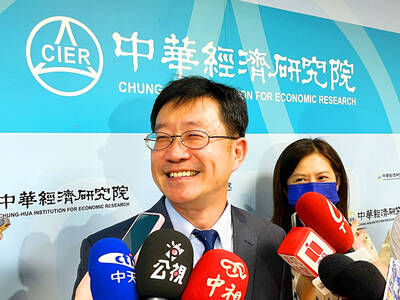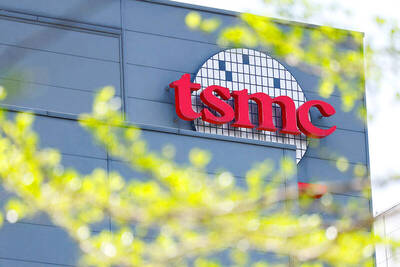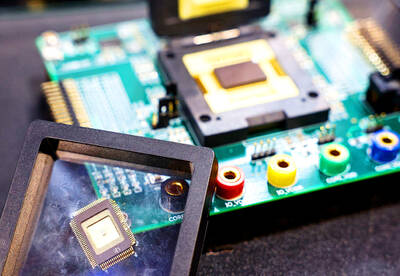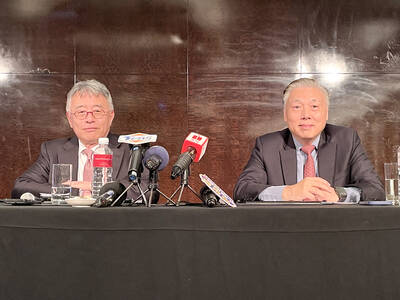The National Communications Commission (NCC) yesterday lowered interconnection fees from mobile phone networks to fixed communication networks, with the connection charge dropping by 15 percent per minute.
The policy is expected to cause Chunghwa Telecom Co (中華電信), which has a monopoly on the fixed communication market, to lose about NT$30 million (US$930,000) in revenue.
Meanwhile, the commission raised the interconnection fees from fixed communication networks to mobile phone networks by about 8 percent per minute.
NCC spokesperson Chen Jeng-chang (陳正倉) said that the new policy would not directly affect the retail price and is simply a recalculation of costs among telecom service providers.
“The commission is about to set a new price cap for retail voice communication charges by the end of this year, and the recalculation of costs may help lower the retail price,” he said.
The NCC said calls made from non-Chunghwa mobile phone networks to fixed communication networks topped 2 billion minutes per year, and fixed to mobile calls reached 1.5 billion minutes.
When a call is made from a fixed communication network to a mobile phone network, the mobile phone service providers have the right to determine the communication charge. While it costs NT$6 per minute to call from a mobile phone to a regular phone, the fixed communication service provider only receives NT$1 of the interconnection fee.
By 2011, however, the right to determine the communication charge will be turned over to the fixed network service provider.

WEAKER ACTIVITY: The sharpest deterioration was seen in the electronics and optical components sector, with the production index falling 13.2 points to 44.5 Taiwan’s manufacturing sector last month contracted for a second consecutive month, with the purchasing managers’ index (PMI) slipping to 48, reflecting ongoing caution over trade uncertainties, the Chung-Hua Institution for Economic Research (CIER, 中華經濟研究院) said yesterday. The decline reflects growing caution among companies amid uncertainty surrounding US tariffs, semiconductor duties and automotive import levies, and it is also likely linked to fading front-loading activity, CIER president Lien Hsien-ming (連賢明) said. “Some clients have started shifting orders to Southeast Asian countries where tariff regimes are already clear,” Lien told a news conference. Firms across the supply chain are also lowering stock levels to mitigate

Six Taiwanese companies, including contract chipmaker Taiwan Semiconductor Manufacturing Co (TSMC, 台積電), made the 2025 Fortune Global 500 list of the world’s largest firms by revenue. In a report published by New York-based Fortune magazine on Tuesday, Hon Hai Precision Industry Co (鴻海精密), also known as Foxconn Technology Group (富士康科技集團), ranked highest among Taiwanese firms, placing 28th with revenue of US$213.69 billion. Up 60 spots from last year, TSMC rose to No. 126 with US$90.16 billion in revenue, followed by Quanta Computer Inc (廣達) at 348th, Pegatron Corp (和碩) at 461st, CPC Corp, Taiwan (台灣中油) at 494th and Wistron Corp (緯創) at

NEGOTIATIONS: Semiconductors play an outsized role in Taiwan’s industrial and economic development and are a major driver of the Taiwan-US trade imbalance With US President Donald Trump threatening to impose tariffs on semiconductors, Taiwan is expected to face a significant challenge, as information and communications technology (ICT) products account for more than 70 percent of its exports to the US, Chung-Hua Institution for Economic Research (CIER, 中華經濟研究院) president Lien Hsien-ming (連賢明) said on Friday. Compared with other countries, semiconductors play a disproportionately large role in Taiwan’s industrial and economic development, Lien said. As the sixth-largest contributor to the US trade deficit, Taiwan recorded a US$73.9 billion trade surplus with the US last year — up from US$47.8 billion in 2023 — driven by strong

ASE Technology Holding Co (ASE, 日月光投控), the world’s biggest chip assembly and testing service provider, yesterday said it would boost equipment capital expenditure by up to 16 percent for this year to cope with strong customer demand for artificial intelligence (AI) applications. Aside from AI, a growing demand for semiconductors used in the automotive and industrial sectors is to drive ASE’s capacity next year, the Kaohsiung-based company said. “We do see the disparity between AI and other general sectors, and that pretty much aligns the scenario in the first half of this year,” ASE chief operating officer Tien Wu (吳田玉) told an